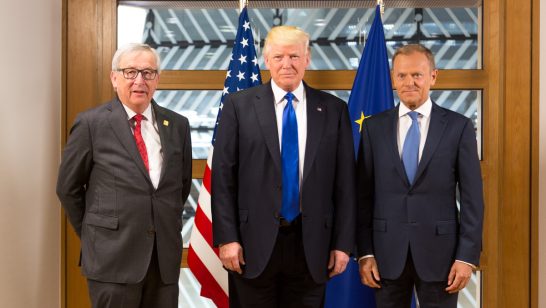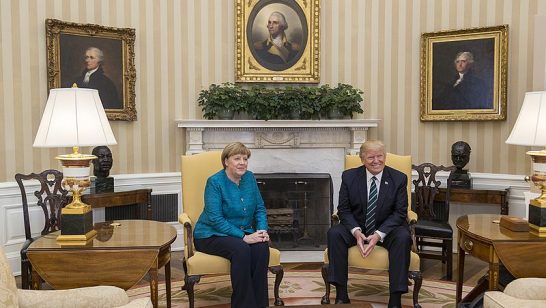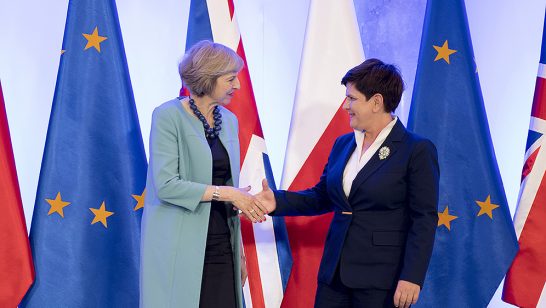
On January 20, when Donald Trump arrived in office as the 45th president of the United States, Europe was not sure what to expect. Would the man that called the NATO alliance “obsolete” and Brexit “a great thing” on the campaign trail eventually come to appreciate the transatlantic relationship and its accompanying institutions? Or would he serve as a disruptor to the European project and transatlantic unity more broadly?
During the first few months of his administration, there were ample signs, especially in engagements with European leaders and statements by Secretary Mattis and Secretary Tillerson, that the president’s views on Europe were indeed evolving and often in an encouraging direction. But each time the transatlantic community breathed a sigh of relief over the last six months, the president tweeted or said something that has cast doubt on that optimism. Europe and committed Atlanticists have therefore been left with more questions than answers.
As with all U.S. administrations, the best way to get ground truth on a president’s worldview is through an actual visit to the region, a crisis of some kind, and the appointments he and his cabinet make at the State Department and the Defense Department. Because this administration has not faced any major crises to date and in light of the fact that they have only filled a fraction of the political posts across the government, Europe waited anxiously for Trump’s first trip to Europe in May.
What Europeans learned from the president’s meetings in Belgium and Italy and what they heard – or rather what they did not hear especially regarding America’s commitment to Article 5 of the NATO Treaty – left little doubt in anyone’s mind. President Trump is not prepared to defend or preserve the European project. Nor does he feel the need to inject U.S. leadership and ideas into transatlantic institutions like NATO. At best, President Trump’s view towards Europe will be one of benign neglect. He might offer tacit support for the transatlantic relationship but will not serve as its champion. At worst, Trump will serve as a disruptor, deliberately challenging NATO and the EU, publicly naming and shaming individual allies, and maintaining a certain level of unpredictability, which he believes is an effective strategy for allies and adversaries alike.
Just days after leaving Europe, Trump announced he would withdraw the United States from the Paris Agreement, issuing a major blow to one of the West’s most recent and greatest achievements. In addition, two of Trump’s closest advisors, H.R. McMaster, the National Security Advisor, and Gary Cohn, Chief Economic Advisor, penned an editorial for the Wall Street Journal, reflecting on the President’s first trip. They wrote, “The president embarked on his first foreign trip with a clear-eyed outlook that the world is not a ‘global community’ but an arena where nations, nongovernmental actors and businesses engage and compete for advantage.” For anyone still holding out hope that Trump would become an advocate of the rules based order, the withdrawal from the Paris Agreement and McMaster/Cohn piece provided pretty damning evidence to the contrary.
Europe is now contemplating the way forward and faces three choices in coping with today’s reality:
Keep Calm and Carry On. Before Trump’s first trip overseas, a number of world leaders had a simple strategy for dealing with the new American president: engage him early and often and find easy wins for his “America First” strategy. Prime Minister Abe of Japan was the first to try and succeed with this strategy. During his campaign, Trump repeatedly called out Japan for its hefty trade imbalance and free riding. In an effort to turn things around, Abe showed up in Mar-a-Lago with infrastructure investments and joined Trump in a round of golf. Theresa May and Angela Merkel tried a similar strategy on their first visits to the Trump White House, focusing on pragmatic steps forward and offering brief tutorials where possible.
The question facing European leaders now is whether they are comfortable staying the course. Some will no doubt conclude that continuing to seek “wins” for Trump and seizing on opportunities to showcase the importance of the transatlantic link is better than the alternative. The only problem with this approach is that it could cost some leaders politically. Given Trump’s very low approval ratings in Europe, European publics could lose patience with any perceived appeasement of Trump and demand a more forceful response. Leaders will then be faced with a choice between maintaining positive ties with Washington and maintaining their own credibility.
Break Glass. If Trump continues to challenge the very foundations of the transatlantic relationship or work directly against the interests of our allies, some leaders may ultimately opt to challenge him directly. That strategy obviously carries real risks, though, as Trump doesn’t react lightly to criticism. Witness Trump’s reaction to Chancellor Merkel’s remarks at a German beer hall where she noted that “the era in which we could fully rely on others is over to some extent.” Despite the fact that her comment really wasn’t directed at Trump or the United States, the president fired back. “We have a MASSIVE trade deficit with Germany, plus they pay FAR LESS than they should on NATO & military. Very bad for U.S. This will change,” he wrote in a tweet. It isn’t hard to imagine how quickly things could spiral out of control if European leaders decided to challenge Trump.
Look Away and Lead: The third and perhaps best option for Europe falls somewhere between appeasement and confrontation. Here, European leaders simply ignore Trump’s tweets, spend less time engaging him directly, invest more in the working relationships with H.R. McMaster, Tillerson, and Mattis, and exert more European leadership. Neither Europe nor the United States can waste precious time arguing over Trump’s latest tweet. There’s simply too much work to do. European leaders, working closely with the Americans inside the Trump administration that believe in U.S. global leadership and engagement (and there are plenty), must carry forward with today’s pressing transatlantic agenda. The list of issues that require our urgent attention is long – Russia, Syria, Turkey, the Balkans, the post-manufacturing economy, climate change, and migration just to name a few. Let’s get to work.
The opinions articulated above represent the views of the author(s), and do not necessarily reflect the position of the European Leadership Network or any of its members. The ELN’s aim is to encourage debates that will help develop Europe’s capacity to address the pressing foreign, defence, and security challenges of our time.



